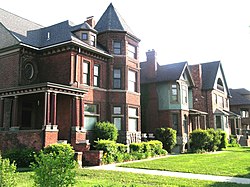East Ferry Avenue Historic District
|
East Ferry Avenue Historic District
|
|

East Ferry streetscape
|
|
| Location | Detroit, Michigan |
|---|---|
| Coordinates | 42°21′42″N 83°3′56″W / 42.36167°N 83.06556°WCoordinates: 42°21′42″N 83°3′56″W / 42.36167°N 83.06556°W |
| Architect | Multiple |
| Architectural style | Châteauesque, Colonial Revival, Queen Anne, Romanesque Revival, Shingle |
| NRHP Reference # | 80001921 |
| Significant dates | |
| Added to NRHP | March 10, 1980 |
| Designated MSHS | December 14, 1976 |
The East Ferry Avenue Historic District is a historic residential district in Midtown Detroit, Michigan. The nationally designated historic district stretches two blocks from Woodward Avenue east to Brush Street; the locally designated historic district includes a third block between Brush and Beaubien. The district includes the separately designated Col. Frank J. Hecker House and the Charles Lang Freer House. It was designated a Michigan State Historic Site in 1976 and listed on the National Register of Historic Places in 1980.
The Inn on Ferry Street is a member of Historic Hotels of America, the official program of the National Trust for Historic Preservation.
In 1856, the Ferry Seed Company was founded in Detroit; the company established a large farm at the corner of East Ferry and Woodward to grow the seeds that were sold nationwide. In the mid-1880s, then-owner D. M. Ferry platted the farm into residential lots along East Ferry Avenue. At the time Woodward was an upscale residential street, so lots facing Woodward were quite expensive (as is the Col. Frank J. Hecker House, on Woodward and Ferry). Lots on the side streets were less expensive, and East Ferry was quickly settled by prosperous middle and upper middle class Detroit residents. Prominent early residents of the district include Col. Frank J. Hecker, colonel in the Union Army and founder of the Peninsular Car Company; Charles Lang Freer, Hecker's partner and noted art collector; William A. Pungs, founder of the Anderson Carriage Company; Herman Roehm, co-owner of Roehm and Weston hardware store; John Scott, a prominent architect; and Samuel A. Sloman, of M. Sloman & Co. furrier.
Woodward Avenue since redeveloped into primarily commercial property, but a group of mansions and upscale housing on East Ferry survives. Around World War I, a number of professionals and business people found they could purchase homes on East Ferry. The Omega Psi Phi fraternity and the Lewis College of Business still remain on East Ferry. After World War II, the Merrill Palmer Institute (housed in the Charles Lang Freer House) purchased several homes along East Ferry, hoping to expand their operations. However, Merrill Palmer was unable to expand and in the late 1960s sold the homes to the Detroit Institute of Arts for their proposed expansion. The DIA eventually realized the property on East Ferry would not be useful to them, and re-sold them in the mid-1990s.
...
Wikipedia
